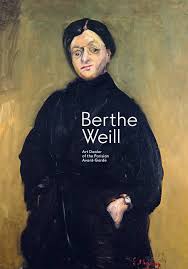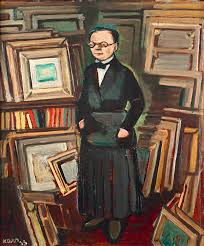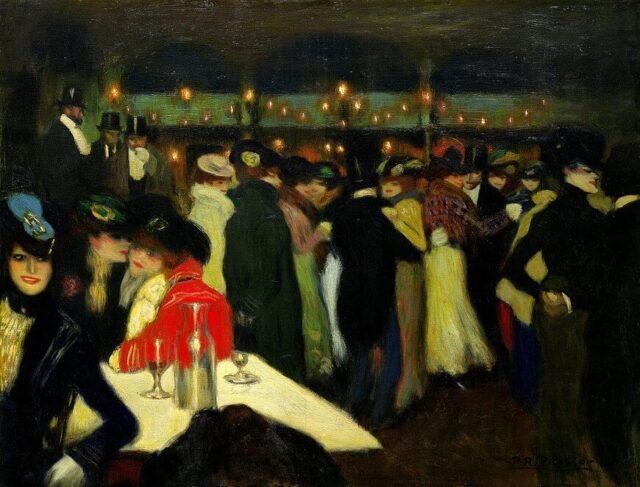
08 Dec TIO NYC: NYU’s Grey Gallery, “Make Way for Berthe Weill,” A Must!
MAKE WAY FOR BERTHE WEILL: ART DEALER OF THE PARISIAN AVANT-GARDE features Berthe Weill (1865-1951), who promoted Matisse and Modigliani, and was Picasso’s first dealer. This overdue tribute show includes many pieces that once hung in her Paris gallery, a treasure trove of fine art – and a must-see now. MAKE WAY FOR BERTHE WEILL is up through March 1.


Bethe Weill was the eye that launched a hundred careers – yet art history showed her little respect.
Until now…
At long last.
Amen.
In 19th century and pre-War Paris, successful art dealers were setting up shop with great success. Names like Rosenberg (Paul or Leonce), Kahnweiler, Cassirer and Goupil might be familiar, but Weill – that’s Berthe Weill – likely not. Yet Weill was buying Picasso pastels before the young Spaniard even moved to Paris, exhibiting them in her eponymous Galerie Berthe Weill when it opened on December 1 1901.
Weill, the child of a relatively poor Jewish family, clearly had great instincts and taste.. She sold contemporary art before the category even had a name, calling her venue “A Place for Youth,” or emerging artists. The following year, Weill, who funded her gallery with the money set aside for her dowry, held a show of 30 early works by Picasso and sold “Moulin de la Galette” (c. 1900) for 250 francs or about $28o to publisher Arthur Huc. That work is now in the Guggenheim collection.

Picasso, Le Moulin de la Galette.
Leo and Gertrude Stein after negotiating Matisse’s first sale, also to Huc, went on to become the first collectors of both Matisse and Picasso.
Weill was also the first dealer for both Surrealist Francis Picabia and Orphist pioneer Robert Delaunay. She also promoted female artists such as Marie Laurencin and Suzanne Valadon long before they became fashionable.
According to the Gallery, “Make Way for Berthe Weill: Art Dealer of the Parisian Avant-Garde” surveys the ground-breaking career of the very first female modern art dealer. Berthe Weill (1865–1951) championed fledgling masters of modern art early on, among the names, all of whom became art world titans: Pablo Picasso, Henri Matisse, and Amedeo Modigliani. There were others, numerous others, who did not achieve wide acclaim, but were still great.
Yet Weill’s role in early 20th-century modernism has, until now, been omitted from most historical accounts in deference to the fraternity of peers who also pilfered some of Weill’s finds – such as Picasso and Matisse, racking in the big bucks for themselves and those artists.
The exhibition features about 110 paintings, drawings, prints, and sculpture, many of which were shown at Weill’s gallery over the first four decades of the 20th century.
The show also includes archival documents – letters, exhibition catalogs, photographs, and journals – that reveal Weill’s deep relationships with a wide range of emerging artists.
Examining Weill’s contributions to the history of modernism as a gallerist, a passionate advocate of contemporary art, and a Jewish woman, the eye-popping, illuminating, long-overdue tribute brings to light the remarkable achievements of a singular figure who overcame sexism, antisemitism, and economic struggles in her quest to promote emerging talent.
Grey Gallery, a brief history:
For nearly 50 years, the Grey Art Museum—formerly known as the Grey Art Gallery—was located within New York University’s Silver Center—the site of NYU’s original home, the legendary University Building (1835 to 1892). Winslow Homer, Daniel Huntington, Samuel Colt, George Innes, and Henry James all lived and worked there, as did Professor Samuel F. B. Morse, who established the first academic fine arts department in America on the museum’s original site.
Demolished in 1892, the original building was replaced by the Main Building (renamed the Silver Center in 2002). Here was located, from 1927 to 1942, A. E. Gallatin’s Museum of Living Art, NYU’s first art museum and the first institution in this country to exhibit work by Picasso, Léger, Mirò, Mondrian, Arp and members of the American Abstract Artists group. Gallatin aspired to create a forum for intellectual exchange, a place where artists would congregate to acquaint themselves with the latest developments in contemporary art. In 1975, with a generous gift from Mrs. Abby Weed Grey, the Museum’s original space was renovated, offices and a collection storage facility were added, and the doors were reopened as the Grey Art Gallery and Study Center.
In 2024, the Grey made a transformative move to a purpose-designed, larger, and more visible space at 18 Cooper Square in lower Manhattan. With this move, the Grey was renamed the Grey Art Museum. The Grey’s new home—with 40% more exhibition space—occupies the entire ground floor of a venerable brick and iron building in the historic NoHo district, its storefront façade facing out onto a busy pedestrian thoroughfare.
Over the last five decades the institution has organized exhibitions that have encompassed all the visual arts: painting, sculpture, drawing and printmaking, photography, architecture and decorative arts, video, film, and performance.
In addition to originating its own exhibitions, some of which travel throughout the United States and abroad, the museum hosts traveling shows that might otherwise not be seen in New York.


Marianne Le Morvan
Posted at 11:31h, 09 DecemberThank you very much for this revue ❤️